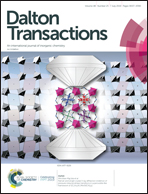Reactivity of the carbodiphosphorane, (Ph3P)2C, towards main group metal alkyl compounds: coordination and cyclometalation†‡
Abstract
The carbodiphosphorane, (Ph3P)2C, reacts with Me3Al and Me3Ga to afford the adducts, [(Ph3P)2C]AlMe3 and [(Ph3P)2C]GaMe3, which have been structurally characterized by X-ray diffraction. (Ph3P)2C also reacts with Me2Zn and Me2Cd to generate an adduct but the formation is reversible on the NMR time scale. At elevated temperatures, however, elimination of methane and cyclometalation occurs to afford [κ2-Ph3PC{PPh2(C6H4)}]ZnMe and [κ2-Ph3PC{PPh2(C6H4)}]CdMe. Analogous cyclometalated products, [κ2-Ph3P{CPPh2(C6H4)}]ZnN(SiMe3)2 and [κ2-Ph3P{CPPh2(C6H4)}]CdN(SiMe3)2, are also obtained upon reaction of (Ph3P)2C with Zn[N(SiMe3)2]2 and Cd[N(SiMe3)2]2. The magnesium compounds, Me2Mg and {Mg[N(SiMe3)2]2}2, likewise react with (Ph3P)2C to afford cyclometalated derivatives, namely [κ2-Ph3PC{PPh2(C6H4)}]MgN(SiMe3)2 and {[κ2-Ph3PC{PPh2(C6H4)}]MgMe}2. While this reactivity is similar to the zinc system, the magnesium methyl complex is a dimer with bridging methyl groups, whereas the zinc complex is a monomer. The greater tendency of the methyl groups to bridge magnesium centers rather than zinc centers is supported by density functional theory calculations.

- This article is part of the themed collection: Challenges in organometallic & coordination chemistry: in celebration of Geoff Cloke’s 65th birthday


 Please wait while we load your content...
Please wait while we load your content...
